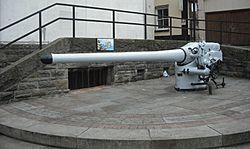William Charles Williams facts for kids
Quick facts for kids
William Charles Williams
|
|
|---|---|

Deck gun from SM UB-91 as a memorial in Chepstow
|
|
| Born | 15 September 1880 Stanton Lacy, Shropshire, England |
| Died | 25 April 1915 (aged 34) Cape Helles, Gallipoli, Ottoman Empire |
| Allegiance | |
| Service/ |
|
| Years of service | 1895 - 1915 |
| Rank | Able Seaman |
| Unit |
|
| Battles/wars | World War I |
| Awards | Victoria Cross |
William Charles Williams (born September 15, 1880 – died April 25, 1915) was a brave British sailor. He received the Victoria Cross (VC), which is the highest award for showing extreme courage in battle for British and Commonwealth soldiers. It's given for amazing acts of bravery when facing the enemy.
Contents
Who Was William Charles Williams?
His Early Life and Family
William Charles Williams was born in a small village called Stanton Lacy in Shropshire, England. His parents were William and Elizabeth Williams. When he was about seven or eight years old, his family moved to Chepstow, Wales. This is where he grew up.
Before joining the Navy, William worked as a gardener and a labourer. In 1895, when he was 15, he joined the Royal Navy Boys Service in Portsmouth. He quickly moved up the ranks, becoming a Boy first class in 1896, a Seaman in 1898, and an Able Seaman in 1901.
Bravery in Early Conflicts
William was known for his courage even before World War I. He was praised for his bravery while serving on HMS Terrible. He helped out during the Second Boer War in South Africa and also during the Boxer Rising in China.
Life Before World War I
In 1910, William left the regular Navy. He joined the Royal Naval Reserve, which is like a part-time Navy. He then worked as a police officer in Newport and also in a steel factory. When World War I started in 1914, he rejoined the Navy to serve his country. During his time as a sailor, he served on 18 different ships!
What Was the Victoria Cross?
The Act of Heroism
William was 34 years old when he earned his Victoria Cross. This happened on April 25, 1915, during a very important landing at V Beach in Cape Helles, Gallipoli, Turkey. William was helping his ship's commander, Edward Unwin, to secure some small boats called lighters. These boats were needed to get soldiers safely to shore.
Facing Extreme Danger
During this time, William stood in the sea with water up to his chest. He held onto a rope for over an hour, even though the enemy was constantly shooting at them. This was an incredibly dangerous situation, but he kept going.
His Sacrifice
Sadly, William was badly hurt by an enemy shell while he was still holding the rope. He later died while his commander was trying to rescue him. Commander Unwin said that William was the bravest sailor he had ever met. His actions helped many soldiers get to shore safely.
Remembering William Charles Williams
Memorials in Chepstow
Since William had no known grave, his name is listed on the Commonwealth War Graves Commission's Portsmouth Naval Memorial. There are also two special memorials for him in Chepstow, the town where he grew up.
- One is a painting by Charles Dixon that shows the brave events in the Dardanelles. This painting hangs in St Mary's Church.
- The other is a large naval gun from a German submarine, SM UB-91. This gun was given by King George V and stands in Chepstow's main square next to the war memorial.
Memorials in Shropshire
In Shropshire, where he was born, there is a memorial plaque for William. It's on the parish war memorial in the churchyard at Stanton Lacy. Later, a special stone was placed in the wall near the village cemetery gate to remember his Victoria Cross award.
Images for kids
-
Deck gun from SM UB-91 as a memorial in Chepstow


